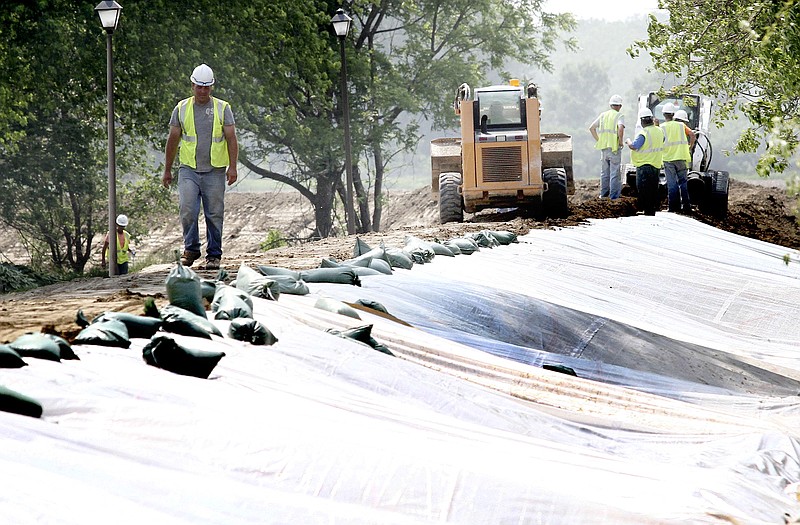When the Missouri River leaped out of its banks in 1993, the floodwaters were merciless, damaging nearly every levee along the swollen channel in its namesake state and inundating thousands of homes, farms and businesses.
But the disaster also prompted a massive effort to rebuild floodwalls and relocate houses to higher ground.
Now that the river is rising again, many communities in its path hope those improvements will pay off, either by holding back the waters or at least minimizing the damage to property and livelihoods. And if the water stays high for weeks, it will present one of the greatest tests of any levee - whether it can sustain pressure from a prolonged flood without crumbling, collapsing or allowing significant leaks.
The flood of 2011 is projected to last for weeks - if not months - as the Army Corps of Engineers releases record amounts of water from its upstream dams due to heavy rains in the West and Upper Midwest and higher-than-usual amounts of melting snow.
Some downstream levees already are in jeopardy. Breaches along an earthen levee just south of the Iowa-Missouri border have sent officials scrambling to erect a secondary floodwall to protect the homes of roughly 1,100 people in Hamburg, Iowa.
Officials at the Army Corps' Kansas City district - which inspects more than 1,000 miles of levees along the Missouri and its tributaries in Missouri, Kansas and Nebraska - hope the levee troubles near Hamburg are the exception, not a predictor of problems to come downstream.
"I think the system as a whole is more reliable than at any point in its history," Jud Kneuvean, the district's emergency management chief, said Tuesday.
When floodwaters butted up against levees in 1993, Kneuvean said, "almost all of them were damaged, and because of that, almost all of them were rebuilt. There was a lot of effort and a lot of money put into them."
In most cases, the levees were rebuilt to the same levels as before the 1993 flood, putting them at the same risk of overtopping but potentially making them better protected against leaks, he said.
More than one-third of the 156 levees in the district's territory have undergone additional repairs within the past few years, Kneuvean said.
In some cases, the levees have been rebuilt bigger than before. The levee protecting the Kansas City suburb of Riverside was easily overcome in 1993, when it was designed to withstand a 25-year flood, which has essentially a 4 percent chance of occurring in any given year. The new and improved Riverside levee is built to a 500-year level, meaning it's supposed to withstand a flood so great that it has only a 0.2 percent chance of happening in any year.
A levee protecting the St. Louis suburb of Chesterfield also has been strengthened and raised, thanks to tens of millions of dollars generated through a special taxing district. In 1993, the Chesterfield levee gave way, flooding the Spirit of St. Louis Airport, a major highway and more than 240 businesses. At the time, the area had an assessed valuation of about $25 million.
With a levee now designed to protect against a 500-year flood, the Chesterfield floodplain has become home to scores of retailers, car dealers and other businesses. In 2008, the area had an economic value of $660 million, according to a presentation at that year's conference of the Association of Conservation Engineers.
John Bales, director of aviation at the Spirit of St. Louis airport, a field serving private planes and jets, has been monitoring the large flows of water being released from upstream dams.
"You always have concerns," Bales said. "But I also feel very comfortable that our levee is much stronger and in much better shape than it was in '93."
The levee on the opposite side of Missouri's Capitol remains at the same height it was in 1993, putting the Jefferson City airport in as much peril as ever. But the earthen levee now shields mostly ball fields and community vegetable gardens instead of scores of houses and businesses.
Nearly all of the 400-plus people who lived in the neighborhood known as Cedar City took advantage of a government buyout of their property in the mid-1990s. By the end of the decade, the state Emergency Management Agency reported that just six people still lived in the area.
Jefferson City's sewage treatment plant - which got swamped in 1993 - has since been elevated to withstand a larger flood.
The corps spent considerable time and money developing plans for a "super levee" to protect the north Jefferson City area containing the airport and wastewater plant, but that levee never was built. The corps also has looked at raising the levee protecting Elwood, Kan. - on the opposite bank from St. Joseph - but the levee remains the same height as when it was overtopped with water in 1993.
Not banking on a better levee, the small east-central Missouri town of Rhineland decided to instead rebuild on higher ground following the 1993 flood.
Since being socked by floods in 1993 and 1995, many residents in the tiny central Missouri town of Lupus also have relocated - not to higher ground, but to a higher level in their own homes. Lupus still does not have levees shielding it from the Missouri River or two nearby creeks. But many people have literally raised their living spaces by putting their homes atop above-ground foundations.
Mayor Sue Denny estimated that the project cost $20,000 per house. The living area of her own home now stands 9 feet higher than in 1993, when the water was 6 feet deep inside. Nonetheless, a flood still would force vehicles to be parked elsewhere and possessions in garages and basements to be moved up.
"It still would be a real pain to have a major flood," Denny said.

